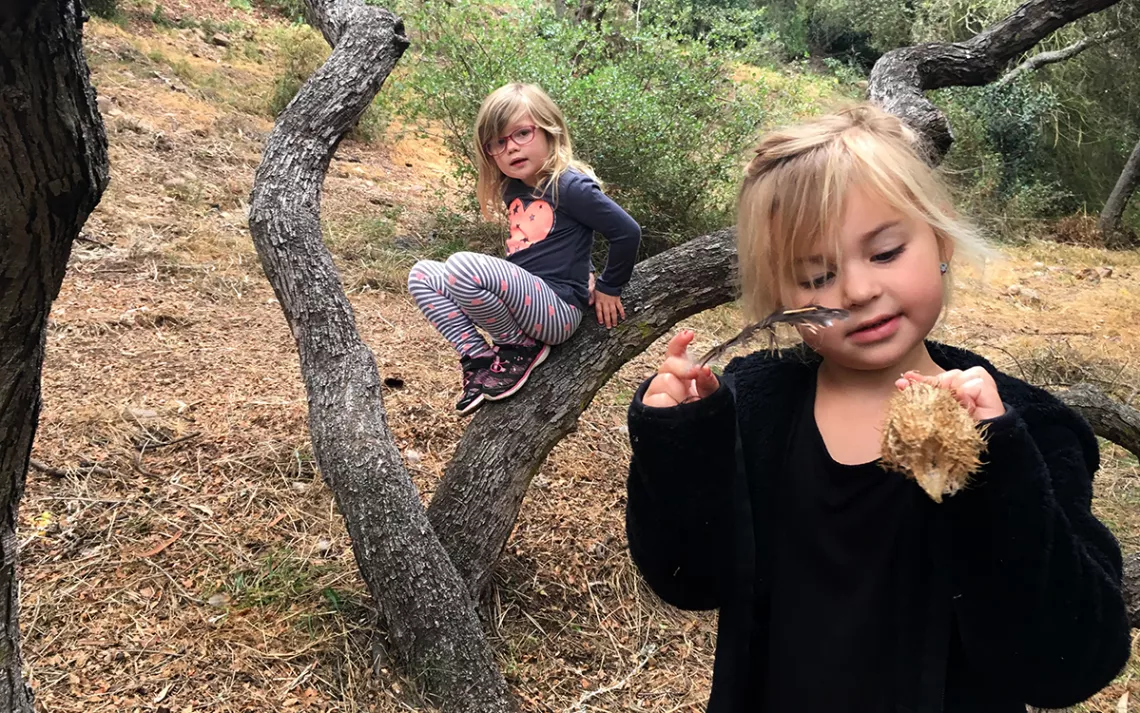When Canyons Are Classrooms and Trees Teach Lessons
Nature-based early education is on the rise in the U.S.

Images courtesy of Enrique Gili
Early on weekday mornings before the sun warms the ground, children tumble out of cars and into San Diego’s residential neighborhood of North Park to run wild for the day.
Waiting for them to arrive is Susan Seiguer, founder and director of the All Friends Nature School. The children’s parents exchange pleasantries and then take their leave. When the last car pulls away, Seiguer breaks into song and the children gather around her. And without any fuss she slowly escorts them into an urban canyon.
Not too long ago, the idea of letting young children loose in the outdoors with adults present but purposefully hands-off seemed like a fringe activity. But nature-based preschool is changing the educational landscape in the United States. The All Friends Nature School is one of three such schools in San Diego County and part of a growing national trend.
“Interest in nature-based preschools has grown considerably in recent years,” says Emilian Geczi, director of the Natural Start Alliance. Indeed, this form of early education seems to be reaching a tipping point, with a growing number of parents and educators coalescing around the idea that no child should remain indoors for too long.
Array
According to a survey conducted by the nonprofit organization, there are 250 nature-based preschools across the United States, up two-thirds since 2017. Geczi says more nature-based preschools will open in city parks within the next two years, based on a surge in interest along the West Coast and in cities across the U.S. renowned for their outdoorsy vibes.
Although adults monitor the children, All Friends Nature School is marked by a choose-your-own-adventure flavor. The students venture outdoors in all weather, equipped with tiny packs loaded with snacks and extra clothes for warmth. A cart loaded with books, crayons, and blankets serves as a rudimentary base camp.
The class spends the day roaming Switzer Canyon under the watchful eye of Seiguer and her two teaching assistants. The kids are encouraged to explore the canyon and to listen rather than talk, so they can hear the sound of the wind rustling through the trees, the chirping of songbirds.
Sticks replace plastic toys, and games are invented. The children, ages three to six, also climb trees (not too high), navigate a ravine, and stop for lunch before hiking out of the urban wilderness and into the arms of their expectant caregivers. "By the end of the day, they're tired and so am I," Seiguer says.
Nature, and a few basic notions about personal and physical boundaries, are woven into the day’s activities, during which teachers observe the children’s behavior to gauge their interest and help engage them with their surroundings.
A bamboo stand can be a fairy garden or the lair of a wild kitty. Meanwhile, emphasis is placed on fostering curiosity and self-confidence, as the children clamber over logs and rocks. By interacting with their environment and with one another, Sieguer explains, the children acquire the social and motor skills critical to their development.
Array
“I think this is an amazing environment for them to learn in, because it allows them to answer their own questions,” says Jennifer Melford, the mother of Jimi, one of a handful of boys enrolled in the preschool.
The terrain becomes part of the lesson plan. A three-year-old following her classmates scrambles uphill along a dried creek bed until a large boulder blocks her path. Rather than cry or pout, with a little bit of encouragement from her teacher, she scrambles around the barrier. A common refrain heard throughout the day: “You can figure it out.”
This also means there are no formal tests or discreet times set aside for reading and math classes typical of more traditional classroom settings. Instead, a teacher will identify plants, or point out the homes of wild creatures. This may turn into creative play periods in which the children sing songs based on what they’ve seen and heard that day. “Nature can teach us a lot, if we choose to look and listen,” says Seiguer.
Nature-based preschools originated during the 1960s and and 70s in Scandinavia and Germany, where they’ve become embedded in classroom curriculum. In the United States, a handful of early adopters opened a few nature-based preschools in the 70s.
But the impulse to get more young children outdoors gained credence in the United States with the release of 2005’s best-selling book Last Child in the Woods by Richard Louv. The book introduced the phrase “nature-deficit disorder” to explain how children no longer spend time alone, exploring nature. He argued that a sedentary way of life was detrimental to a child’s development and linked lack of outdoor play to a host of childhood ailments, ranging from allergies to obesity and even to depression.
According to Catharine Jordan, a spokesperson for the Children and Nature Network, Last Child in the Woods struck a chord among the parents of school-aged children. “The book has fueled a movement; it’s almost become living room language,” she says.
Jordan attributes the rise in popularity of nature-based preschools to the downward pressure placed on young children to score well on tests, or as she calls it, the “academification of kindergarten.” Parents’ pushback to the federal mandate that requires testing at every grade school level, she says, has led to a surge in demand for more placed-based learning environments. School-aged children as young as six years old are expected to participate in statewide exams, which many parents and educators contend takes the joy out of learning. “Parents recognize there’s something wrong with that,” Jordan says.
Parents concerned about raising a generation of tech-addled teens and tots are also looking to nature for answers. A growing body of evidence supports Louv’s premise that too much screen time at an early age short-circuits developing minds, and one way to reboot a generation of over-stimulated children fused to their technology, he argued, is to break the cycle by getting them outdoors more often.
A less popular but perhaps equally influential book among outdoor educators, according to Gezci, is an intimate portrait of cabin life in Maine by one of America’s preeminent 20th-century nature writers.
First published in 1965, Rachel Carson’s classic essay “The Sense of Wonder” describes the beauty of Maine’s dense woods and rugged coastline, experienced while in the company of her young nephew Roger. Carson conveys the importance of observing nature during its many moods, and the delight her nephew took in wandering a living landscape that adults often failed to notice, or took for granted.
If a child is to keep their sense of wonder alive, Carson wrote, they must have “the companionship of one adult who can share it, rediscovering with him the joy, excitement, and mystery of the world we live in." Decades after its initial publication, educators and parents are buying into this philosophy. Carson urged readers to explore nature through their senses and to limit the impulse to categorize or to define. Stoke the emotions, she admonished, because the foundation for lifelong learning is based on discovering what we love.
Array
 The Magazine of The Sierra Club
The Magazine of The Sierra Club



